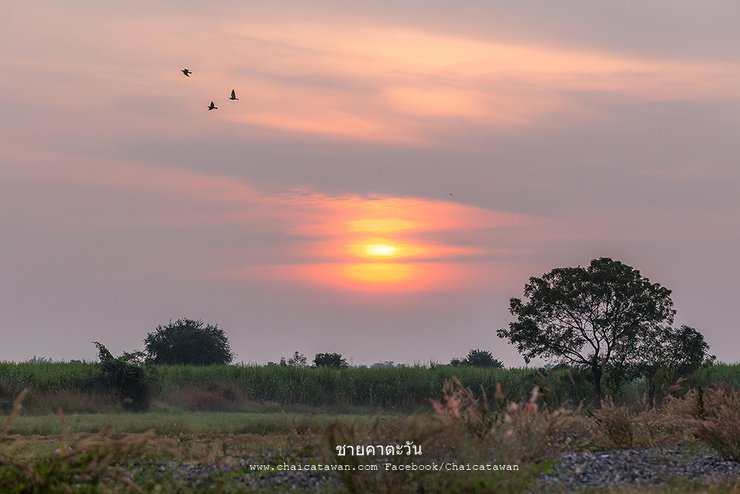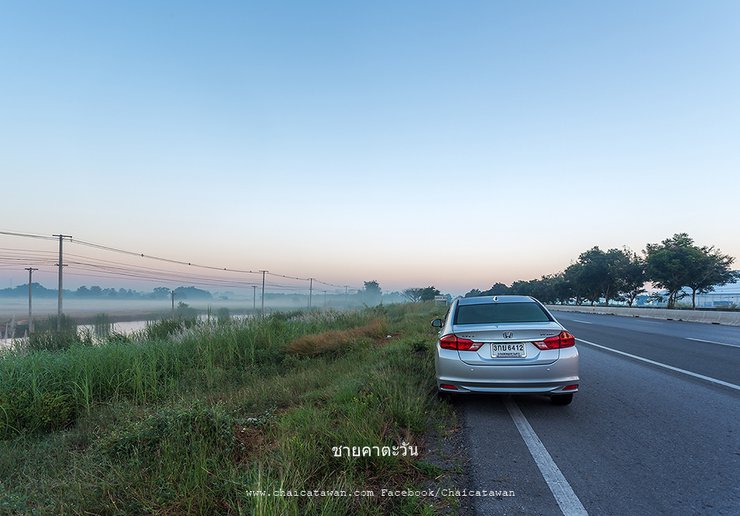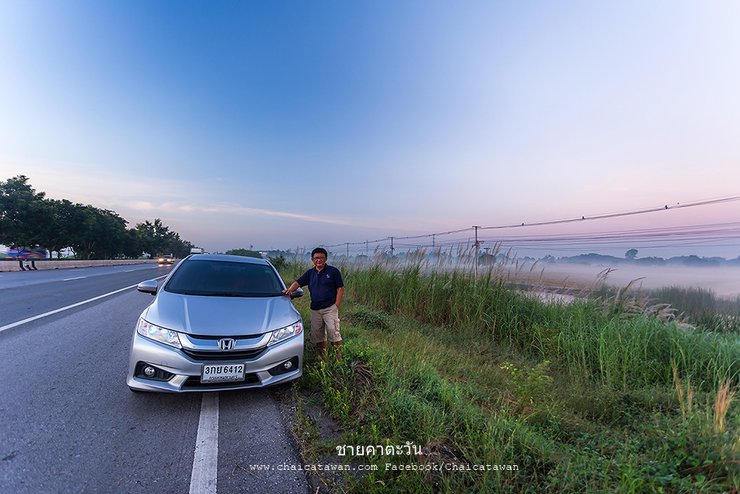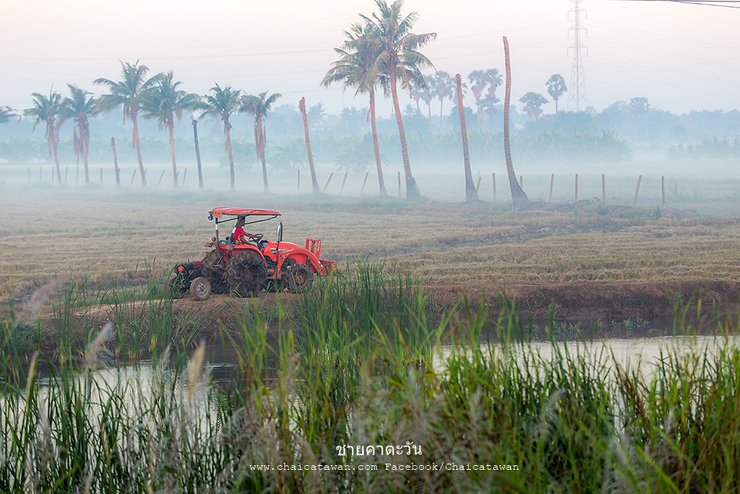The cool breeze of winter has arrived, and I believe that many people, including myself, often think of high mountains and various peaks. For this trip, I would like to invite my friends to experience the cool breeze and nature together. Let's go and let our minds be free, allowing nature to heal us. And the place that I always think of during the winter is the high-altitude tourist attractions, which are various royal projects initiated by our beloved King. In fact, I would like to visit many places, following in His Majesty's footsteps. However, due to limited time and the abundance of His Majesty's projects, I will have to gradually follow in His footsteps.

.
.
For this trip, I drove north to Chiang Rai province. Although the distance was long, the cold weather and the beautiful scenery of the mountains made me feel like it was not far at all.

.
I left the capital city at dawn, around 5 am. I drove leisurely, not in a hurry. I think this is a good way to travel. I can enjoy the scenery along the way and stop to take pictures of anything beautiful I see.








.
Before entering Chiang Rai on this trip, I stopped to pitch a tent and sleep amidst the mist at Phu Lanka Resort in Pong District, Phayao Province, for one night. I was rewarded with a breathtaking sea of mist.




.
Wat Rong Suea Ten, Chiang Rai Province
Leaving Bhulangkari Resort in the late morning, we took photos along the way, arriving in Chiang Rai in the late afternoon. We checked into a hotel before heading to Wat Rong Suea Ten for photos.
Wat Rong Suea Ten is the work of Salanok, or Mr. Phutta Kabkaew, a local Chiang Rai artist and student of Ajarn Chalermchai Kositpipat, the creator of the world-famous and stunning Wat Rong Khun.

.
The architectural style of Wat Rong Suea Ten is considered an adaptation of traditional Thai art. The flowing patterns and intricate designs were inspired by the teachings of Ajarn Chalermchai Kositpipat, a renowned Thai artist. While Ajarn Chalermchai's work typically features white tones and incorporates the use of mirrors, Wat Rong Suea Ten has adopted a distinct blue and sky-blue color scheme. Additionally, the temple showcases unique adaptations in specific elements, such as the serpent's fangs, which draw inspiration from the works of Ajarn Thawan Duchanee, known for his masterful depictions of curved horns and tusks.

.
The Buddha Subduing His Kin
The pavilion is located behind the main hall, and it is equally beautiful. This spot is also popular among tourists for taking photos. I had to wait for the right moment, but as I waited, the sky started to get too dark.

.
Phra That Choeng Chum (Choeng Chum Pagoda)
Located behind the Rong Suea Ten Temple's main hall, this spot offers a picturesque backdrop for photos with the temple.

.
The pinnacle of the Phra That stupa enshrines a relic of the Buddha, gifted by His Holiness Somdet Phra Ariyavongsagatanana, the Supreme Patriarch of Thailand. This sacred site is a must-visit for pilgrims and visitors alike.

.
Phra Buddha Rachmongkol Bodhi Tri Lokanath
The interior of the temple features intricate artwork and a stunning white jade Buddha statue, known as "Phra Phuttha Ratchamongkol Bodhi Tree Lokanath," measuring 5 meters wide and 6.5 meters tall. This statue houses 88,000 Phra Rod Luang Pu statues and numerous precious jewels embedded beneath it.

.
The Buddha's head enshrines sacred relics bestowed by His Holiness Somdet Phra Yanasangworn, the Supreme Patriarch of Thailand. The Buddha was also granted the royal name Phra Phuttha Ratchamongkhon Bodhi Tri Lokanath, which signifies "The Buddha, the auspicious sovereign, the refuge of the three realms."

.
.
**Day 2: Heading to Doi Tung, Mae Fah Luang District**
Doi Tung has been on my bucket list for a while, and this was my first visit. I was eager to see the Queen Mother's projects and camp under the stars to enjoy the fresh mountain air. The drive up Doi Tung is straightforward, with clear signage. From Chiang Rai, take Highway 1 to Mae Chan District and turn left to ascend Doi Tung. The road is well-maintained and has wide shoulders, making for a comfortable drive.


.
Doi Tung is located in Mae Fah Luang District, in the Nang Non mountain range, within the Chiang Rai National Forest Reserve and at the heart of the Golden Triangle. It is home to various hill tribes who live in poverty and lack basic infrastructure. As a result, many have resorted to opium cultivation, negatively impacting the economy.

.
In 1987, Her Royal Highness Princess Srinagarindra visited Doi Tung and recognized the challenges faced by the local community. Committed to improving their quality of life and fostering a sustainable relationship with nature, she initiated the Doi Tung Development Project (DTP) in 1988. This initiative aimed to restore the forest cover of Doi Tung while simultaneously revitalizing the region's economy, society, and environment. By promoting alternative cash crops to replace opium cultivation, the DTP empowered the local population to achieve self-sufficiency and coexist harmoniously with the forest.

.
I drove slowly up Doi Tung, and soon arrived at the scenic viewpoint at kilometer 12. The view was beautiful, with many local vendors selling their wares. There were also cafes and souvenir shops.


.
The image above depicts a mountain village called Akha Pa Kluay. Unfortunately, I was unable to visit the village myself. However, I understand that it offers camping and homestay accommodations.

.


.
This is a coffee shop with a beautiful view. Imagine sipping coffee while enjoying the natural beauty of the forest mountains. It must be quite an experience.


.
Let me take a picture with the mountain view. There are not many people around now, so I'm not shy. Hehe.

.
Nearby, there is a camping ground. Before setting up my tent, I drove up to Doi Tung Temple to pay my respects. The road leading up to Doi Tung Temple is comfortable to drive on, with two options: the old and the new route. The old route is shorter but steeper.

.
Doi Tung Stupa is a renowned and sacred stupa in Chiang Rai province, particularly revered by those born in the Year of the Pig. Its ancient architecture and beauty make it a significant landmark.


.
Located on a mountain peak approximately 2,000 meters above sea level.


.
The Doi Tung Stupa features two stunning golden pagodas standing side by side.

.
After paying respects at the Phra That, I took some photos and then went back down to set up my tent at the viewpoint, which wasn't far away. I pitched my tent on a flat area near the viewpoint at km 12. The local Tambon Administrative Organization (TAO) has prepared this area for camping, and tourists can camp here for free. There are restrooms available at the viewpoint for a 5 baht fee per person. The walk to the restrooms might be a bit long.

.
The weather on Doi Tung is cool, but not too cold. There are about 10 tents of tourists camping, which I think is a good number. It's not too crowded.

.
I went out for a walk late at night to take pictures of the stars. The moon was very bright tonight, and I didn't get many stars, but the atmosphere was amazing. It wasn't too cold.



.
The morning mist was a pleasant surprise. The atmosphere was serene, with few people around, making for a relaxing and uncrowded photo session.




.
The viewpoint offers stunning views, with a distant glimpse of the sea of mist. Although there was no mist near the viewpoint, the sunrise and the beautiful sky provided a breathtaking alternative.



.
As the sun rose, more tourists began to visit to enjoy the view.





.
The sky is exceptionally clear today, boasting a beautiful color that is pleasing to the eye.


.
.
Mae Fah Luang Garden
In the morning, I packed up my tent and drove to the Mae Fah Luang Garden, which is located near the Royal Palace. There is ample parking available. However, if you are visiting on a weekend, it is advisable to park your car first. This is because if you drive closer to the garden, you may not find a parking spot and have to drive back to find one.

.
Parked the car and walked in.

.
Purple cars are available for transportation services, near or far.

.
Golf cart rentals are available for 1,000 baht per hour.

.
Today, I purchased a garden-only admission ticket for 90 baht.


.
Upon entering the garden with my ticket, I was greeted by the stunning beauty of the Mae Fah Luang Garden for the first time. After passing through the ticket booth, I came across a path adorned with paintings of Her Royal Highness the Princess Mother and His Majesty the King, surrounded by vibrant flowers.



.
Portraits of the King and Queen Mother adorn the walkway.


.
Mae Fah Luang Garden is located in front of Doi Tung Palace, covering an area of approximately 10 rai. It is quite a walk.





.
Mae Fah Luang Garden boasts a diverse collection of over 70 species of cold-weather flowers, including salvias, roses, brugmansias, petunias, begonias, auspicious plants, and various trees and climbing vines.




.
The highlight is the continuous sculptures by artist Mitseaem Yib-insoi.
Continue walking to admire the beauty of the garden.


.
Continuing to walk, admiring the beauty of the garden.


.
This is a nice place to sit. I'm tired from walking, so it's good to rest for a bit. Hehe.

.
The light and shadow are playing beautifully, creating a captivating scene worth capturing.

.
Mae Fah Luang Garden is open daily from 6:30 AM to 6:00 PM.
.
Come outside. Go back to where the car is parked.



.
Before leaving, I stopped by the Doi Tung Market to buy some local products made by the hill tribe people to bring home.


.
.
After visiting the Mae Fah Luang Garden and learning about the projects that Her Royal Highness Princess Srinagarindra has implemented to help hill tribe people live a sustainable and high-quality life, I went to visit a friend in Mae Sai district. On the way to my friend's house, he suggested that I visit a school located just before Mae Sai. This school has a project that teaches students to apply the sufficiency economy philosophy of King Bhumibol Adulyadej the Great. The project encourages students to grow their own vegetables and raise animals for consumption within the school, and any surplus is sold to generate income. I found this project very interesting and decided to stop by for a visit.

.
The entrance to the school is beautiful.


.
This school is called Ban San Khong School, located in Sri Mueang Chum Subdistrict, Mae Sai District, Chiang Rai Province.



.
Watching children play at school evokes memories of my own childhood, making me wish I could turn back time.





.
A project that applies the sufficiency economy philosophy of King Rama IX to educate children is called the "100 Schools of Sufficiency Economy" project. I recently learned that this project is supported by Tod Piti Bhirombhakdi of Singha Corporation.


.
The 100 Self-Sufficient Schools project teaches children self-reliance skills such as raising chickens, fish, and pesticide-free vegetables, as well as mushroom cultivation. This provides ingredients for school lunches, with any surplus sold at the market or to families for home consumption at below-market prices. The school uses the income generated to cover expenses. This sustainable learning approach teaches children both production and marketing skills, while also fostering teamwork.


.
The school teachers explained that the school already had a self-sufficiency project for school lunches, which involved raising fish in cages and growing vegetables. Singha Corporation then provided additional funding and expanded the project to include raising laying hens, catfish, indigenous vegetables, and cultivating oyster mushrooms.


.
In addition to school teachers, there is also a local wisdom expert, Ms. Phanpimol Pan Kam, from the Sustainable Agriculture Wisdom Center in Sri Mueang Chum Subdistrict, Mae Sai District, who also helps teach the children. For example, on the day I visited, I saw Ms. Phanpimol teaching about vegetable planting, from soil preparation, seed preparation, seed sowing, sowing, and care, including watering.


.
Children wearing green scarves will plant local vegetables, such as kale, basil, lettuce, and Chinese cabbage, using organic farming methods.




.
The children seemed to be having a lot of fun tending to the vegetable patch.





.
Fish farming at Ban Sankhong School involves two methods: cage and concrete pond养殖. The school employs both methods, with cage养殖 offering the advantage of faster fish growth and eliminating the need for water changes, unlike concrete pond养殖. Students are assigned to specific tasks based on the color of their scarves, with red scarves indicating fish farming responsibilities.

.
In the oyster mushroom cultivation process, children wear yellow scarves. The cultivation takes place in a tightly enclosed greenhouse, as mushrooms are sensitive to wind, which can dry them out. The children's role is to water the mushrooms to maintain the optimal temperature for their growth, ensuring high-quality production.

.
Wearing yellow scarves, the children tend to the chickens, collecting eggs for cooking and selling.

.
.
After photographing the children's activities, I continued my journey. My destination was the sea of mist on Phu Chi Fa. I took Highway 1 into Chiang Rai before ascending Phu Chi Fa from the direction of Thoeng District.

.
This route is not very steep in my opinion, and it's a stress-free drive with clear road signs.



.
The weather started out clear, but then turned cloudy as if it were about to rain.

Drive and take photos, stopping to relax along the way.
.
We stopped by a strawberry farm with a beautiful view, although the sky was a bit hazy. The strawberry plants were bearing fruit, but the yield wasn't substantial yet. The owner informed us that they had recently harvested a large batch.




.
I arrived at my destination near dusk and set up my tent at the Good View Campsite at Phu Chi Fa, which boasts stunning views. The campsite rental fee is only 100 baht per person.

.
The twilight tonight is stunning, and the tents are beautifully colored.


.
I have to wake up at 4 am tomorrow to go to Phu Chi Fa viewpoint. I hope to see the beautiful sea of mist, but yesterday the sky was not clear and the wind was very strong, so the chance of seeing the sea of mist is low. I will use the villagers' pickup truck service from the tent site to the parking lot. The fare is 30 baht up and 30 baht down.

.
After reaching the parking lot, we had to hike another 700 meters or so. Our hopes were dashed as thick fog blanketed the area, making visibility almost impossible.

.
Tourists, united in their misfortune, waited with hope that the sky would clear and reveal the sea of mist.


.
However, the sea of mist did not appear as expected. Instead, there was only a light mist scattered throughout the area.


.
This is the third time I haven't seen the beautiful sunrise with the sea of fog.

.
I must come again... Phu Chi Fa.

.
Travel with a smile in our Thailand.
From the heart... the roof of the sun
ชายคาตะวัน
Friday, October 4, 2024 3:07 PM

![cover [Sunrise over the roof of the north].. Rising in the north during the cold season, experiencing the cool air on the mountain, and observing the simple way of life of children in Chiang Rai Province.](https://asset.readme.me/files/50784/cover.jpg?v=d09fa956)
![cover [Sunrise over the roof of the north].. Rising in the north during the cold season, experiencing the cool air on the mountain, and observing the simple way of life of children in Chiang Rai Province.](https://asset.readme.me/files/50784/thumb.cover.jpg?v=d09fa956)







![Cover [Sun's Roof]...Chill Out in Chiang Rai with Thai Smile Airways...](https://asset.readme.me/files/51108/thumb.cover.jpg?v=d09fa956)
![Cover [Roof of the Sun]...Inviting you to visit Kanchanaburi to pay respec...](https://asset.readme.me/files/50918/thumb.cover.jpg?v=d09fa956)
![Cover [Under the eaves of the sun].. Slowly approaching Nan, we pay respec...](https://asset.readme.me/files/50534/thumb.cover.jpg?v=d09fa956)


